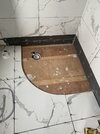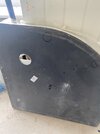Hi
I’ve got a tile tray and I’m planning to lay it on the floor pictured. I’ve inset the ply between the joists as I’m trying to minimise any height increase (dormer with low roof). The more I look at it the more I think it’ll move too much. The ply is 18mm and is attached with some battens underneath that go into the joist so my expectation is it’ll mostly move together if it does. I think I can spare another 6-12mm. I’ve got some 12mm ply that I could stick over the top. I’m just wondering if cement board would be worth the £20 expense to go and get some today.
Some parts of the ply sit slightly proud of the joist. About 3mm in the worst parts. I was thinking I could balance that out with the tile adhesive.
If it’s ply the plan is to Sbr it and then set the tray on a bed of slow set tile flexible tile adhesive.
If I do go cement board it’d be the same but don’t think I need to Sbr it.
Would appreciate some input as I’m second guessing myself.
The tiles are sat on 6mm cement board on top of 18mm ply. Not that it’s relevant.
Cheers all
I’ve got a tile tray and I’m planning to lay it on the floor pictured. I’ve inset the ply between the joists as I’m trying to minimise any height increase (dormer with low roof). The more I look at it the more I think it’ll move too much. The ply is 18mm and is attached with some battens underneath that go into the joist so my expectation is it’ll mostly move together if it does. I think I can spare another 6-12mm. I’ve got some 12mm ply that I could stick over the top. I’m just wondering if cement board would be worth the £20 expense to go and get some today.
Some parts of the ply sit slightly proud of the joist. About 3mm in the worst parts. I was thinking I could balance that out with the tile adhesive.
If it’s ply the plan is to Sbr it and then set the tray on a bed of slow set tile flexible tile adhesive.
If I do go cement board it’d be the same but don’t think I need to Sbr it.
Would appreciate some input as I’m second guessing myself.
The tiles are sat on 6mm cement board on top of 18mm ply. Not that it’s relevant.
Cheers all
Attachments
Last edited:



